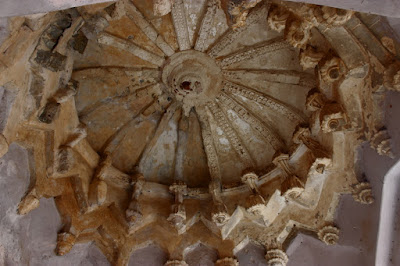Queen's Bath is one of the most visited and liked spots of Hampi. The four-sided enclosure houses a water pavilion open to the sky. Around the bath area is a rectangular corridor with screens. The corridor's roof is decorated with equally spaced several domes, every dome is unique.. a mix of floral, and geometric patterns. Few have imitation of metal chains. The domes' perimeter are circular, star, octagonal, hexagonal or square shaped. These 500 year old art works are not easy to maintain yet they are preserved well - thanks to the care-takers.
We went around clockwise starting near the entrance. This is an octagram with lotus at the center. Most domes have lotus at the center. These art works are made of mortar.. wondering how they worked supported the wet material.
The next two domes are squares and stepped.. like an inverse Gopura.
Octagram ~ octagonal star inside an octagon.
16-spoke wheel and a Lotus hub.
Dome of chandeliers and chains.
Large lotus dome.
Off all domes, this is the only asymmetric design.
This looks like a spiderweb ..however, it seems more like a net created of metal strips with rivets at intersections.
Another form of octagonal star. The eight stripes diverging from the hub look like a ceiling fan blades. They also be perceived as eight converging stripes.
A cart-wheel.
Lotus in full bloom and 8 chains.
An octagonal star with diamond shaped niches. The circular dome's perimeter is lined with little intersecting arches. This is probably the most beautiful of all domes here.
An complex octagonal star ..unfortunately the hub is missing.
A eight-pointed star, its center is a hollow octagon.
This is another chandelier and chain dome, sadly the art work has fallen off.
The arches around the perimeter seems like balconies.
A eight-blade ceiling fan. Simple yet elegant.
Another web of metal strips and chains.
The care-taker referred to this dome as a jhumki ..a type of jewelry worn by women.
Another lotus.
All these designs are a mix of Hindu and Islamic art. The octagon star is a symbol of AshtaLakshmi. The Lotus is again a sacred flower in Hinduism. The metallic chains and stripes seem to be Islamic, so are the diamond-shaped niches. From the looks these seem to be created by junior or trainee artists.. that's my opinion. Vijayanagara kings did spend a lot on luxury which did create employment for artists. Its quite possible some of these art work might be designed by the king's family members.
Here's a link to my account of the first visit.. the
Queen's Bath House.
.........






























































